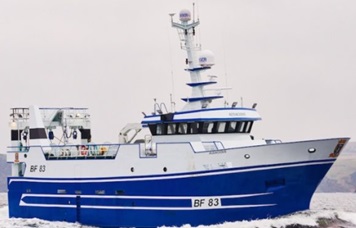Tag Archives: fishing gear
California expands test of traps to help delayed Bay Area crabbing season: What this means for crabbers
 For fisherman Brand Little, the specialized ropes connecting his crab traps are a financial lifeline. The experimental “pop-up” system is designed to prevent whales from getting entangled, by keeping lines on the ocean floor until a crew launches them by remote control to reel in the traps. And thanks to a special testing permit, he’s been able to fish into the spring crabbing season, which was cut-short several years ago to protect the migrating whales. “This is a tipping point, and I can’t stress this enough. This is a tipping point at getting our spring fishery back. It’s been six years. You know, you got to look at where we came from, where we’re at and where we’re headed,” said Brand Little. Video, more, >>CLICK TO READ<< 09:57
For fisherman Brand Little, the specialized ropes connecting his crab traps are a financial lifeline. The experimental “pop-up” system is designed to prevent whales from getting entangled, by keeping lines on the ocean floor until a crew launches them by remote control to reel in the traps. And thanks to a special testing permit, he’s been able to fish into the spring crabbing season, which was cut-short several years ago to protect the migrating whales. “This is a tipping point, and I can’t stress this enough. This is a tipping point at getting our spring fishery back. It’s been six years. You know, you got to look at where we came from, where we’re at and where we’re headed,” said Brand Little. Video, more, >>CLICK TO READ<< 09:57

The 1929 Magnitude 7.2 “Grand Banks” earthquake and tsunami
On November 18, 1929, at 5:02 pm Newfoundland time, a major earthquake occurred approximately 250 km south of Newfoundland along the southern edge of the Grand Banks. This magnitude 7.2 tremor was felt as far away as New York and Montreal (see isoseismal map of felt area below). On land, damage due to earthquake vibrations was limited to Cape Breton Island where chimneys were overthrown or cracked and where some highways were blocked by minor landslides. A few aftershocks (one as large as magnitude 6) were felt in Nova Scotia and Newfoundland but caused no damage. More than 40 local villages in southern Newfoundland were affected, where numerous homes, ships, businesses, livestock and fishing gear were destroyed. Also lost were more than 280,000 pounds of salt cod. Total property losses were estimated at more than $1 million 1929 dollars (estimated as nearly $20 million 2004 dollars). Photos, maps, more, >>CLICK TO READ<< 10:23
Ropeless gear program will keep P.E.I. snow crab harvester on water despite whale sightings
 Alden Gaudet fishes snow crab out of Tignish Run and is close to reaching his quota for the season. The first sighting of a right whale in Canadian waters in 2024 came last Friday. A whale that has been dubbed Shelagh was seen northeast of New Brunswick and northwest of the Magdalen Islands. After that led to a partial closure of fishing grounds near his traps, Gaudet reached out to CanFish, a free gear-lending program based in Halifax that’s operated by the Canadian Wildlife Federation. Photos, more, >>CLICK TO READ<< 17:36
Alden Gaudet fishes snow crab out of Tignish Run and is close to reaching his quota for the season. The first sighting of a right whale in Canadian waters in 2024 came last Friday. A whale that has been dubbed Shelagh was seen northeast of New Brunswick and northwest of the Magdalen Islands. After that led to a partial closure of fishing grounds near his traps, Gaudet reached out to CanFish, a free gear-lending program based in Halifax that’s operated by the Canadian Wildlife Federation. Photos, more, >>CLICK TO READ<< 17:36
Crab fishermen test pop-up fishing gear to reduce whale entanglements
 Traditionally, the Dungeness crab fishing season runs from November through June using vertical line fishing gear that spans from the surface to the seafloor. After whale entanglements spiked from 2015 to 2018, the Dungeness crab season has faced delay or closure since 2019. Season closures are affecting the fishing business, but now during this closure, a handful of commercial fishermen such as Brand Little, are testing a whale-safe kind of fishing gear, called “pop-up” or “ropeless” fishing gear, hoping the state will authorize this alternative for use next season, so fishermen can still work. Commercial fisherman Brand Little described how the first test of the spring season went with about 20 fishermen. Video, more, >>CLICK TO READ<< 08:59
Traditionally, the Dungeness crab fishing season runs from November through June using vertical line fishing gear that spans from the surface to the seafloor. After whale entanglements spiked from 2015 to 2018, the Dungeness crab season has faced delay or closure since 2019. Season closures are affecting the fishing business, but now during this closure, a handful of commercial fishermen such as Brand Little, are testing a whale-safe kind of fishing gear, called “pop-up” or “ropeless” fishing gear, hoping the state will authorize this alternative for use next season, so fishermen can still work. Commercial fisherman Brand Little described how the first test of the spring season went with about 20 fishermen. Video, more, >>CLICK TO READ<< 08:59
Lineless Lobster Launches The Gear Guardian as a Low Cost Rapidly Deployable Interim Solution to the Entanglement Crisis
 Lineless Lobster proudly announces the launch of its new project aimed to help address the Right Whale entanglement issue with a product called “The Gear Guardian.” The Gear Guardian is a low cost mechanical device with no electronics that attaches to any lobster trap in minutes. It is designed to reduce the occurrence and severity of Right Whale entanglements, provide a way to rescue otherwise lost “ghost gear” and prove a consumer demand for ethically sourced lobster. “It hit me two years ago-I love whales but hate the way the entanglement issue with Right Whales is playing out. It’s painful seeing Lobstermen hit with unfair regulations and at the same time watching good science be ignored or debated,” says Chris Buchanan, Founder of Lineless Lobster. links, more, >>click to read<< 09:33
Lineless Lobster proudly announces the launch of its new project aimed to help address the Right Whale entanglement issue with a product called “The Gear Guardian.” The Gear Guardian is a low cost mechanical device with no electronics that attaches to any lobster trap in minutes. It is designed to reduce the occurrence and severity of Right Whale entanglements, provide a way to rescue otherwise lost “ghost gear” and prove a consumer demand for ethically sourced lobster. “It hit me two years ago-I love whales but hate the way the entanglement issue with Right Whales is playing out. It’s painful seeing Lobstermen hit with unfair regulations and at the same time watching good science be ignored or debated,” says Chris Buchanan, Founder of Lineless Lobster. links, more, >>click to read<< 09:33
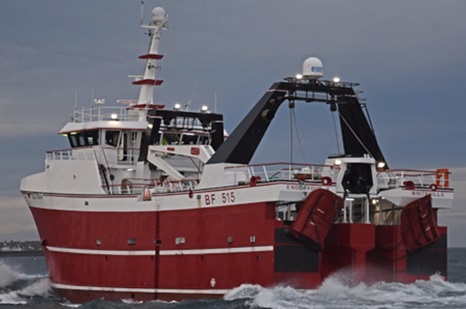
Storm Doors and Zenith Trawl – a Perfect Match
When Whitehills skipper David Lovie took delivery in 2020 of the 34-metre trawler Endeavour V, he opted for a pair of Vónin’s Storm trawl doors. “The Storm doors have proven to be powerful, highly durable and robust. Unlike our previous doors that required replacement every 12 months, we were able to use these for a remarkable 31 months before considering a replacement. Last year he travelled to Hirtshals with Vónin to observe a variety of fishing gears streamed in the flume tank, and immediately liked the look of the Zenith groundfish trawl. The outcome was an order a Zenith 572 trawl, which has met all of his expectations – and he described the Zenith trawl and 4.50m3 Storm doors as “a perfect match.” photos, more, >>click to read<< 08:57

Changing to batten lobster pots found to improve catch efficiency, meaning less days at sea
South Australia’s southern rock lobster fishers have not been using the best pots, according to the results of a five-year study testing different designs, with the West Australian batten pot coming out on top. When directly compared to the beehive pot, which is legislated for use in South Australia, batten pots improved catch efficiency rates by 38 per cent. Some fishers in SA’s northern zone have already decided to switch to batten pots. Emily Rowe is the shore manager for a lobster fishing  business based in Port Lincoln who took part in the trial and then decided to make the permanent switch to batten pots this year. South Australian Northern Zone Rock Lobster Association executive officer Kyri Toumazos said it would not be long before most professional fishers made the switch. Photos>>click to read<< 13:54
business based in Port Lincoln who took part in the trial and then decided to make the permanent switch to batten pots this year. South Australian Northern Zone Rock Lobster Association executive officer Kyri Toumazos said it would not be long before most professional fishers made the switch. Photos>>click to read<< 13:54
NOAA Fish Surveys: A way to improve – Capt. Sam Novello
 First, you need the net, then a set of doors capable of spreading, the net and ground wire, and bridles connected to the net. The angle of attack should be at 15 degrees, this angle is best for catching flounders, cod and haddock. The lower of the angle will catch more flounders. This is the reason why R/V Bigelow did an inadequate job of catching flounders & codfish, (overspreading the net) The best net will not fish properly if the doors are not synchronized with the net. People are talking about a new net for fish surveys, which means more research is needed, more time lost and more money wasted. >click to read< 13:30
First, you need the net, then a set of doors capable of spreading, the net and ground wire, and bridles connected to the net. The angle of attack should be at 15 degrees, this angle is best for catching flounders, cod and haddock. The lower of the angle will catch more flounders. This is the reason why R/V Bigelow did an inadequate job of catching flounders & codfish, (overspreading the net) The best net will not fish properly if the doors are not synchronized with the net. People are talking about a new net for fish surveys, which means more research is needed, more time lost and more money wasted. >click to read< 13:30
Nova Scotia fishermen on the hook for gear destroyed by historic wildfires
 A volunteer firefighter who battled one of Nova Scotia’s biggest wildfires must now shell out thousands of dollars to replace the fishing gear he lost to the flames. Kevin Doane says the fire that burned more than 200 square kilometres in southwest Nova Scotia in late May and June destroyed about $61,000 worth of his lobster fishing gear. Recently, the Nova Scotia government announced a $2,500 grant for aquaculture operators, harvesting businesses, and licensed fish buyers and processors affected by the wildfires. Doane, a lobster fisherman of nearly 50 years, equates the $2,500 grant to “a really big insult.” >click to read< 15:29
A volunteer firefighter who battled one of Nova Scotia’s biggest wildfires must now shell out thousands of dollars to replace the fishing gear he lost to the flames. Kevin Doane says the fire that burned more than 200 square kilometres in southwest Nova Scotia in late May and June destroyed about $61,000 worth of his lobster fishing gear. Recently, the Nova Scotia government announced a $2,500 grant for aquaculture operators, harvesting businesses, and licensed fish buyers and processors affected by the wildfires. Doane, a lobster fisherman of nearly 50 years, equates the $2,500 grant to “a really big insult.” >click to read< 15:29
N.S. fishermen say province isn’t doing enough to cover wildfire losses
 Kevin Doane was living in Roseway, N.S., when the fire broke out in late May. He said his losses include 100 lobster traps, rope and fishing gear. With the cost of a new trap sitting at around $300, he said he needs roughly $30,000 for traps alone. Some fishermen are out hundreds of thousands of dollars, he said. “This is a big loss and all we’re asking for is some of the money, our tax dollars back that we’ve paid in,” said Doane, who was living in Roseway, N.S., at the time of the fires. Fisherman Kasey DeMings said the support is inadequate. “It’s not enough to do anything,” he said. “It really isn’t. It wouldn’t even be a drop in the bucket to start rebuilding.” DeMings is a volunteer firefighter whose Carleton Village, N.S., home burned down in the wildfires while he was out fighting fires. >click to read< 07:43
Kevin Doane was living in Roseway, N.S., when the fire broke out in late May. He said his losses include 100 lobster traps, rope and fishing gear. With the cost of a new trap sitting at around $300, he said he needs roughly $30,000 for traps alone. Some fishermen are out hundreds of thousands of dollars, he said. “This is a big loss and all we’re asking for is some of the money, our tax dollars back that we’ve paid in,” said Doane, who was living in Roseway, N.S., at the time of the fires. Fisherman Kasey DeMings said the support is inadequate. “It’s not enough to do anything,” he said. “It really isn’t. It wouldn’t even be a drop in the bucket to start rebuilding.” DeMings is a volunteer firefighter whose Carleton Village, N.S., home burned down in the wildfires while he was out fighting fires. >click to read< 07:43
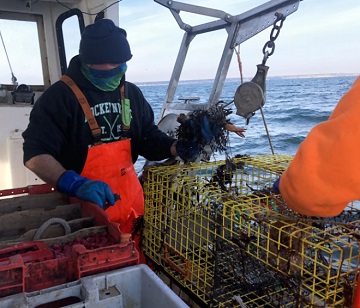
A discussion – Costs of using ropeless fishing gear could sink MA lobster fishery: new report
Experts often say the lobster fishery will have to move to innovative “ropeless” fishing gear to protect North Atlantic right whales from entanglement. There fewer than 340 of the critically endangered whales left. But a new report says Massachusetts lobstermen may be headed for troubled economic waters if they make the switch. But here’s what’s really crazy: the state found that even if lobstermen were just given the on-demand gear for free, using government and nonprofit subsidies, they would still go from making $15 million per year in revenue to just $2 million in revenue per year. And the biggest impacts would be on smaller, more independent operators. I talked to the report author about this, Noah Oppenhiem. He said for lobstermen that only fish only a couple traps per vertical line, they’d go from needing 6 and a half minutes to haul up some lobsters to 11 and a half minutes. >click to read< 11:56
Mass DMF’s On-Demand Fishing Gear Economic Modeling Report Released – >Click to read<

World’s First All-Electric Longline Handling System
F/V Kap Farvel is the first fishing boat in the world that started using the all-electric longline handling system from Mørenot. Already after one week of testing followed by seven weeks of fishing, the feedback from the skipper and crew is unanimous: This is the longline system of the future! For several years, Mørenot has been challenging the idea of a traditional hydraulic longline system with its first fully electric longline system for both deep sea and coastal fisheries. Seeing the opportunity of a high-tech electrical longline system, Mørenot has heavily invested in innovation that enables fishers to effortlessly achieve higher efficiency, lower energy consumption, and better working conditions. Mørenot’s VP Alf Rune Ose explains how their engineers in Iceland developed the complete mechanical system with an updated LineTech longline control system to revolutionize the fishing industry. Mørenot has designed a system that is suitable for fishing operations worldwide. photos, >click to read< 21:16

National: Legal Petition Seeks Federal Ropeless Rule to Save Whales, Turtles From Fishing Gear
The Center for Biological Diversity formally petitioned the National Marine Fisheries Service to require crab, lobster and other trap fisheries to convert to new ropeless or “pop-up” gear within the next five years. The petition requests that the agency prioritize the transition in national marine sanctuaries.,, The proposed change would protect whales and other animals from entanglements in California’s Dungeness crab fishery, New England’s lobster fishery, the stone crab fishery in the Gulf of Mexico, and others. >click to read< 07:17

EU ‘fly-shooting’ fishing boats in Channel spark concerns
The UK has been accused of allowing a fleet of mainly EU “fly-shooting” fishing boats “unfettered access” to the Channel, without a proper assessment of the impact on fish populations, the seabed or the livelihoods of small-scale fishers. Organisations representing small-scale fishers on both sides of the Channel have warned that the fleet is having a “devastating” effect on their catches. They are calling for a review of the vessels’ UK licences until an impact assessment has been carried out. Fly-shooter fishing boats, sometimes called Danish or Scottish seiners,,, >click to read< 08:41

Nearly 30 years into the moratorium, Newfoundlanders look for ways to rebuild Cod
Atlantic cod, the species better known by its population name, Northern cod, is the fish of choice for Newfoundlanders and Labradorians. On a day spent handlining cod on the North Atlantic off of Petty Harbour-Maddox Cove, a centuries-old fishing community just outside of St. John’s, it can be easy to forget cod has a storied history – and a still uncertain future. Northern cod survived near-decimation from overfishing three decades ago, leading the federal department of Fisheries and Oceans Canada (DFO) to shutter the commercial cod fishery in 1992. Meant to last two years, the cod moratorium remains in effect, although DFO reopened an inshore commercial fishery, called the “stewardship fishery,” in 2006. >click to read< 11:00

West Australian crabber invents new pot, triples his catch rate, and has best season in 15 years
It is an industry that has suffered disastrous blows including a marine heatwave in 2011, flood waters that caused the stock to decimate and a local industry shutdown for three years. However, managing director Peter Jecks said this year was the best season in a long time. At the start of the 2019/2020 season the Jecks family, who own and operate the fishery, were faced with a dilemma that saw them invest more than $400,000 into developing a plastic-injection molded crab pot. Mr Jecks said it turned out to be a revelation in catching efficiencies. photo’s, video >click to read< 09:23

Dramatic footage reveals full extent of damage from massive fire that tore through warehouse on San Francisco’s Fisherman’s Wharf
Dramatic photos have revealed the full extent of damage from a fire that engulfed a warehouse on San Francisco’s Fisherman’s Wharf early Saturday morning. Pictures taken after the blaze was extinguished show the structure destroyed by the fire, with its walls and roof collapsed. The blaze broke out shortly before dawn, sending a thick plume of orange smoke out across San Francisco Bay. Later in the morning, dozens of firefighters were seen surveying the smoldering building as smoke continued to billow across the city. lots of photos, video, >click to read< 13:52

The Maine Man, Wayne Hamilton
Wayne Hamilton has built Hamilton Marine into a successful accessories business by making sure he takes care of his customers.,, He had gotten his mother and mother-in-law to co-sign separate $10,000 business loans, and in 1977, Hamilton opened a wholesale account with Manset Marine in Rockland, Maine. He started out selling marine equipment from his garage. Every Wednesday, he’d load up his mustard-colored Chevy Blazer and snowmobile trailer with marine equipment and go to the commercial fishing co-ops to sell gear to the commercial anglers. One new piece of equipment he had was survival suits. They weren’t yet required on commercial vessels, and the fishermen worked year-round in Maine, so he would go to the co-ops early in the morning and ask if they wanted to see him jump in the water. >click to read< 19:35

Why we must break free from the rotten EU fisheries system
The Common Fisheries Policy, a rigid political structure that works against nature.,,, To understand the significance of this research, it is important to understand how nets (trawls) are constructed.,,, Separator trawls were designed with a panel inserted horizontally throughout the trawl, with two cod-ends, one top section for haddock and one at the bottom for cod (Cod ends are the end of the trawl, where the catch ends up, and is emptied into where the catch is sorted.) The Canadians took this research further. They were concerned about their shrimp fishery,,, >click to read< 11:04
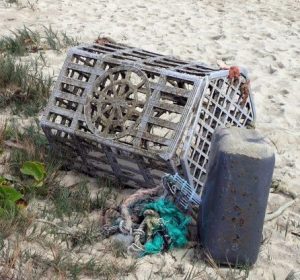
How much fishing gear is lost at sea, worldwide?
The first ever estimate of commercial fishing gear lost in the world’s oceans has been published by CSIRO, Australia’s national science agency. Abandoned, lost or otherwise discarded fishing gear or ‘ghost gear’,,, Until now there has not been a clear global picture of the quantity and type of fishing gear lost worldwide.,,Using data from 68 studies Currently, much of the data on gear loss is from the United States and Europe, highlighting the need for more information about gear losses in the African, Asian, South American and Oceania regions. >click to read< 16:27

New nets make shrimp trawling more sustainable in Latin America and Caribbean
The FAO is conducting the project, known as The Sustainable Management of Bycatch in Latin America and Caribbean Trawl Fisheries (REYBAC LAC II), between 2015 and 2020 with the intention of meeting international guidelines for the responsible management of bycatch. With the help of traditional and large-scale fishers, the project consists of testing net prototypes that reduce the negative effects of trawling on marine biodiversity while still catching shrimp. The new nets have different characteristics than those usually used by fishers, mainly in regard to the size of the holes in the fabric of the net. >click to read<10:34

New Zealand: Regulatory approval of new innovative trawl technology
Fisheries New Zealand has approved the use of the Precision Seafood Harvesting (PSH) Modular Harvest System (MHS) in North Island inshore fisheries for snapper, tarakihi, trevally, red gurnard, and John dory with specific conditions. Stuart Anderson, Director Fisheries Management at Fisheries New Zealand, says innovation in the fishing industry is important to deliver sustainability benefits and is a key step in the journey to shift to higher value products. “In granting this approval Fisheries New Zealand is satisfied that this system performs at least as well as traditional mesh trawl nets, while ensuring sustainability benefits,” says Mr Anderson. >click to read<20:30

Crab fishermen and environmentalists square off over whale entanglements
The issue has pitted two local interest groups against each other: Those who depend on the $68 million California Dungeness crab fishery for their livelihood, and those who advocate shutting down areas to crabbing to protect humpback whales and other endangered species. Caught in between are everyday shoppers who love having Dungeness crab on their tables, but probably wouldn’t want marine mammals hurt in the process. “I’m frankly very scared of what the upcoming season could mean for whales,” said Kristen Monsell, senior attorney at the Center for Biological Diversity, an Oakland environmental group that sued the state over the issue last year. The case is due to go before a judge in February. >click to read<13:23

The Sago Extreme – Closing the longline snackbar
Sisters on the west coast of Norway have provided the impetus behind the development of a system designed to protect longline catches from predating whales that treat the lines as a free lunch. Ingunn Elise and Linn Solveig Sørvik took an idea their father Omar had originally come up with some years before, and have taken it to the stage of being a commercial product ready for use. Omar Sørvik came up with the idea while he was working on longliners fishing for toothfish in the Southern Ocean, where sperm and killer whales stealing fish from the lines as they are hauled is a serious problem for fishing vessels. >click to read<16:41

An Anti-Fishing Town? Home Storage Of Fishing Gear Dredged Up Anew
“Fishing has always been an important industry in Orleans,” Orleans Planning Board vice chair Chet Crabtree said Aug. 14. “We don’t want to discourage those who fish. On the other hand…there are people who have multiple boats and lobster pots stacked up quite high in the face of neighbors. I’ve heard complaints from other homeowners.” The town has not been aggressive in requiring special permits for such storage, and some may have “abused that laxness,” Crabtree said. >click to read<08:20
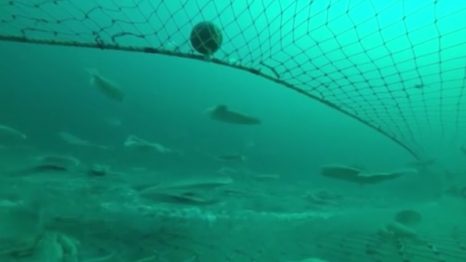
Making demersal seines more precise
Demersal seines are so effective that the haul can become unmanageable. It has also been difficult to avoid bycatches when using them. Since 2013, fisheries researchers at the Institute of Marine Research have been working to redesign this fishing gear. One aim of the recently completed project was to find a way to separate species. >Video, click here to read< 09:58
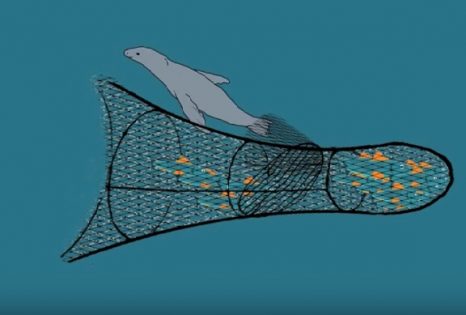
Are Excluder Devices Saving Sea Lions or Covering Up Their Deaths?
A new study blames the fishing industry for the New Zealand sea lion’s decline, but some scientists have doubts.,,, To cut down on collateral damage, some fisheries employ excluder devices, special nets that allow unwanted animals to escape without forfeiting target fish. Australian fishers use seal excluder devices, or SEDs, while turtle excluder devices (TEDs) allow reptiles to pass through American trawls. click here to read the story 11:21

Door control from the wheelhouse
The idea of a pair of trawl doors that can be adjusted at the turn of a dial rather than by shifting attachment points and backstrops has been at the back of many people’s minds over the years – and there have been numerous experiments and trials carried out to get this to work. It has taken a while, and finally the first commercially-produced controllable pelagic trawl doors are available, produced by Esbjerg company MLD, an acronym that stands simply for Multi-Level Door. click here to read the story More images click here18:23







